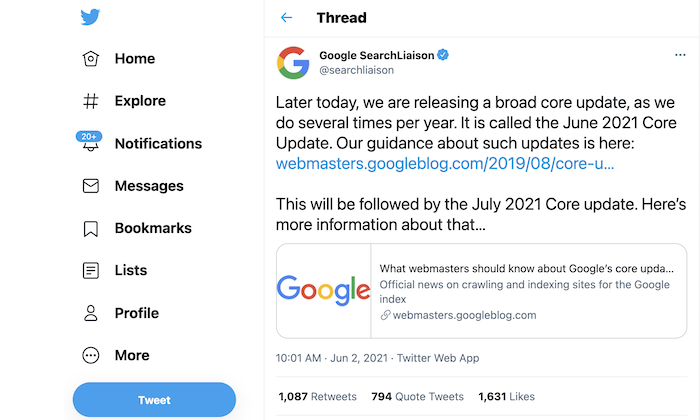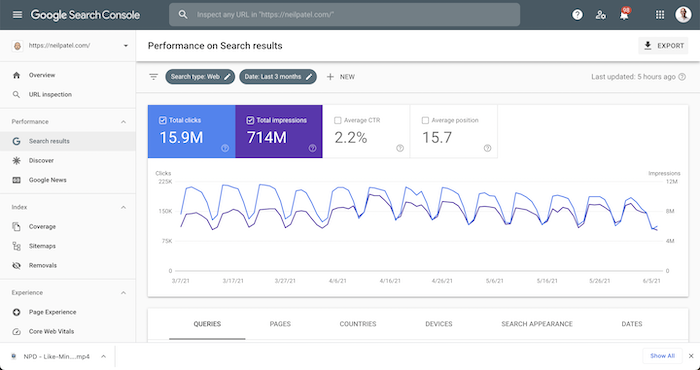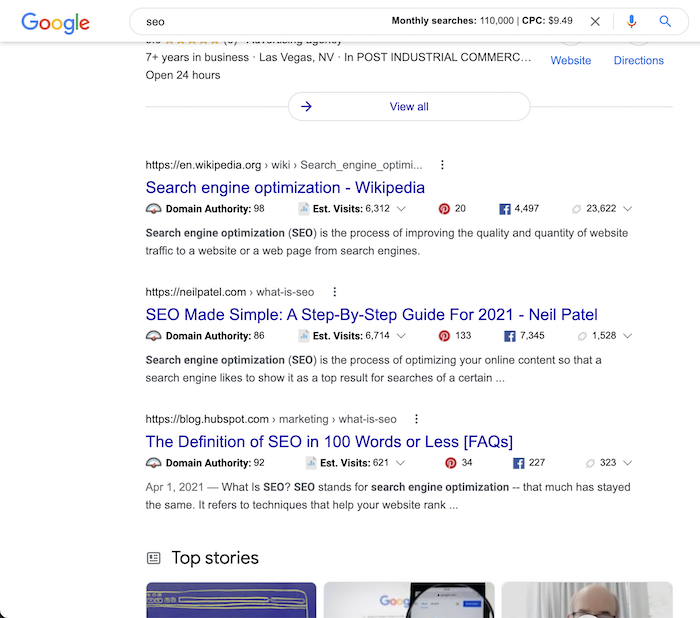
On June 2nd Google released a core update. And in July there will be another one.
During the first few days, most of us marketers and SEOs saw little to no changes in our rankings or search traffic.
But on Sunday June 6th, many of started noticing shake ups.
Some of my friends saw declines and others saw gains.
Remember, when someone drops in rankings, someone else takes their spot. So when there are losers, there are also winners.
But what’s beautiful is that I have an ad agency. And because we have hundreds of clients all over the globe in all different industries, I am able to see trends very quickly.
And I noticed something in this update that was a bit unique…
But first…
My traffic dropped
I’ve had core updates that have helped me and hurt me. That’s why I believe as a marketer you have to take an omnichannel approach.
For example, at my agency we generate clients through:
- SEO
- Ads
- Word of mouth/client referrals
- Partnership program
- Outbound sales
- Social media marketing
- Podcasting
- Speaking at conferences
- By hiring good people who have connections and can potentially bring clients
- Ubersuggest
The list goes on and on, but those are just some of the ways we get customers. Hence, I don’t like fully relying on 1 channel as that’s too risky.
For example, here is our TV commercial that we are running soon (the ad still needs some editing and it’s not done yet).
But my traffic dropped roughly 9%. It could drop even more over the next few days or weeks, but that is where I am at right now.

But when I dove into my numbers and looked at my clients who have done well throughout this update, I noticed a trend.
Google doesn’t want fluff
Most of my traffic drop of course came to my blog pages.
But with my blog posts, I typically start them out with storytelling.
For example, here is my post on SEO.
I currently rank on page 1.

But look at my title tag…
SEO Made Simple: A Step-by-Step Guide For 2021
And here were the first few paragraphs of the post…
Guess how many blog posts people publish each day.
Any ideas?
Well, WordPress users alone publish over 2 million posts every day. That comes out to 24 blog posts every second.
That means that users published around 216 blog posts while you were reading these five sentences.
And that’s only counting WordPress users. If we were to count all blog posts, that number would surely be higher.
This makes it kind of tough to stand out. But you have to if you want to make your blog a successful one.
While I often spend 4-5 hours writing my blog posts, the ten minutes I spend optimizing each post are easily the most important.
No wonder millions of people Google the term “SEO” month.
My posts that used storytelling, didn’t do as well. When I write I typically create hooks to try and draw people in.
But my clients and even my sites that used that approach didn’t do as well compared to the sites that didn’t use hooks.
And the sites that started ranking above me in many cases (not all), were just writing ordinary content also didn’t leverage storytelling or infographics or did much that was unique.
When someone Google’s SEO, based on the top 10 results they are looking to learn what SEO is and how to do it.
In other words, they want their answer right away and they want you as a marketer/writer to get to the point right away.
So, then I started to modify a lot of my content, which will take a lot of work.
Now the new title of the post is “What is SEO? (Learn SEO in 5 Minutes)”
I now start the post going right into what SEO is by giving my definition of it.
Will that increase my traffic? Time will tell and I probably will have to do multiple tests on all of my title tags and my content to get it right.
But the best way to rank well in the long run is to put yourself in the searchers shows and give them what they want.
It’s not about optimizing for time on site or bounce rate. It’s about optimizing for giving the user what they want as quick as possible.
Are there other things to look out for?
Yes, there are other things that Google of course changed in this algorithm update.
As they say, core updates are big.
Even the trend we found probably isn’t coded into their algorithm the way we may all think. I doubt Google adjusted their code to hurt sites with “fluff”.
Instead I believe they look at user signals and tried to optimize for what users want.
As the other changes, we are still diving through data and crunching it to see if we can find more patterns. It’s early, but we will probably find more and of course I will update you as I do.
Conclusion
Go through your content, especially the introductory paragraphs within your blog posts and test removing fluff.
Get to the point and give people what they want.
It’s a great way to improve the user experience.
Yes, it may decrease your word count or time on site, but none of that matters. Focus on getting users what they want as quickly as possible.
How did you do in the latest update?
How to Deal with the June Google Core Update
Publicado Primeiro em Neil Patel
Nenhum comentário:
Postar um comentário